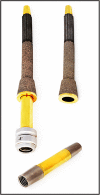Single-stage osseointegrated reconstruction and rehabilitation of lower limb amputees: the Osseointegration Group of Australia Accelerated Protocol-2 (OGAAP-2) for a prospective cohort study
- PMID: 28336738
- PMCID: PMC5372148
- DOI: 10.1136/bmjopen-2016-013508
Single-stage osseointegrated reconstruction and rehabilitation of lower limb amputees: the Osseointegration Group of Australia Accelerated Protocol-2 (OGAAP-2) for a prospective cohort study
Abstract
Introduction: Lower limb amputations have detrimental influences on the quality of life, function and body image of the affected patients. Following amputation, prolonged rehabilitation is required for patients to be fitted with traditional socket prostheses, and many patients experience symptomatic socket-residuum interface problems which lead to reduced prosthetic use and quality of life. Osseointegration has recently emerged as a novel approach for the reconstruction of amputated limbs, which overcomes many of the socket-related problems by directly attaching the prosthesis to the skeletal residuum. To date, the vast majority of osseointegration procedures worldwide have been performed in 2 stages, which require at least 4 months and up to 18 months for the completion of reconstruction and rehabilitation from the time of the initial surgery. The current prospective cohort study evaluates the safety and efficacy of a single-stage osseointegration procedure performed under the Osseointegration Group of Australia Accelerated Protocol-2 (OGAAP-2), which dramatically reduces the time of recovery to ∼3-6 weeks.
Methods and analysis: The inclusion criteria for osseointegrated reconstruction under the OGAAP-2 procedure are age over 18 years, unilateral transfemoral amputation and experiencing problems or difficulties in using socket prostheses. All patients receive osseointegrated implants which are press-fitted into the residual bone. Functional and quality-of-life outcome measures are recorded preoperatively and at defined postoperative follow-up intervals up to 2 years. Postoperative adverse events are also recorded. The preoperative and postoperative values are compared for each outcome measure, and the benefits and harms of the single-stage OGAAP-2 procedure will be compared with the results obtained using a previously employed 2-stage procedure.
Ethics and dissemination: This study has received ethics approval from the University of Notre Dame, Sydney, Australia (014153S). The study outcomes will be disseminated by publications in peer-reviewed academic journals and presentations at relevant clinical and orthopaedic conferences.
Keywords: Lower limb amputees; Osseointegration; Single-stage surgery.
Published by the BMJ Publishing Group Limited. For permission to use (where not already granted under a licence) please go to http://www.bmj.com/company/products-services/rights-and-licensing/.
Conflict of interest statement
Figures



Similar articles
-
Osseointegrated reconstruction and rehabilitation of transtibial amputees: the Osseointegration Group of Australia surgical technique and protocol for a prospective cohort study.BMJ Open. 2020 Oct 20;10(10):e038346. doi: 10.1136/bmjopen-2020-038346. BMJ Open. 2020. PMID: 33082192 Free PMC article.
-
Osseointegrated Prosthetic Implants for People With Lower-Limb Amputation: A Health Technology Assessment.Ont Health Technol Assess Ser. 2019 Dec 12;19(7):1-126. eCollection 2019. Ont Health Technol Assess Ser. 2019. PMID: 31911825 Free PMC article.
-
The Osseointegration Group of Australia Accelerated Protocol (OGAAP-1) for two-stage osseointegrated reconstruction of amputated limbs.Bone Joint J. 2016 Jul;98-B(7):952-60. doi: 10.1302/0301-620X.98B7.37547. Bone Joint J. 2016. PMID: 27365474
-
Osseointegrated Prosthetic Limb for the treatment of lower limb amputations : Experience and outcomes.Unfallchirurg. 2017 Apr;120(4):306-311. doi: 10.1007/s00113-016-0296-8. Unfallchirurg. 2017. PMID: 28070628 Review. English.
-
Surgical technique of a transcutaneous osseointegration prosthesis system (TOPS) for transtibial amputees.Oper Orthop Traumatol. 2025 Apr;37(2):89-100. doi: 10.1007/s00064-025-00888-8. Epub 2025 Feb 19. Oper Orthop Traumatol. 2025. PMID: 39969578 Free PMC article. Review.
Cited by
-
Radiological evaluation before and after treatment with an osseointegrated bone-anchor following major limb amputation-a guide for radiologists.Skeletal Radiol. 2024 Jun;53(6):1033-1043. doi: 10.1007/s00256-023-04524-z. Epub 2023 Dec 4. Skeletal Radiol. 2024. PMID: 38044373 Free PMC article. Review.
-
Qualitative Analysis of the Lived Experience of Individuals After Undergoing Osseointegration for Transfemoral Amputation.Adv Rehabil Sci Pract. 2024 Aug 31;13:27536351241271538. doi: 10.1177/27536351241271538. eCollection 2024 Jan-Dec. Adv Rehabil Sci Pract. 2024. PMID: 39220729 Free PMC article.
-
The safety of one-stage versus two-stage approach to osseointegrated prosthesis for limb amputation.Bone Jt Open. 2023 Jul 21;4(7):539-550. doi: 10.1302/2633-1462.47.BJO-2022-0117.R1. Bone Jt Open. 2023. PMID: 37475711 Free PMC article.
-
Health Service Delivery and Economic Evaluation of Limb Lower Bone-Anchored Prostheses: A Summary of the Queensland Artificial Limb Service's Experience.Can Prosthet Orthot J. 2021 Sep 21;4(2):36210. doi: 10.33137/cpoj.v4i2.36210. eCollection 2021. Can Prosthet Orthot J. 2021. PMID: 37614998 Free PMC article.
-
Development of an evidence-based diagnostic algorithm for infection in patients with transcutaneous osseointegration following amputation.J Bone Jt Infect. 2024 Feb 6;9(1):49-57. doi: 10.5194/jbji-9-49-2024. eCollection 2024. J Bone Jt Infect. 2024. PMID: 38600998 Free PMC article.
References
MeSH terms
LinkOut - more resources
Full Text Sources
Other Literature Sources
Medical
